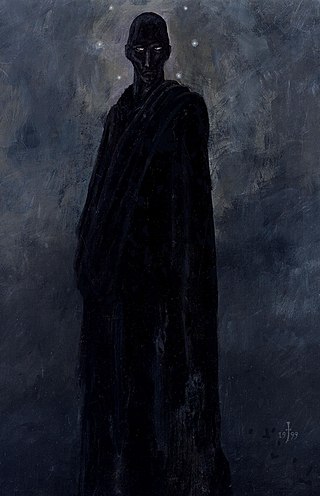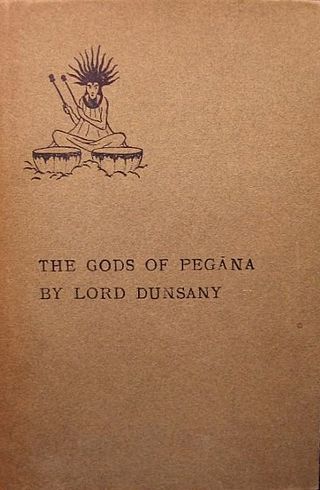Related Research Articles

Edward John Moreton Drax Plunkett, 18th Baron of Dunsany,, commonly known as Lord Dunsany, was an Anglo-Irish writer and dramatist. He published more than 90 volumes of fiction, essays, poems and plays in his lifetime, with a modest amount of material published posthumously. He gained a name in the 1910s as a great writer in the English-speaking world. Best known today are the 1924 fantasy novel, The King of Elfland's Daughter, and his first book, The Gods of Pegāna, which depicts a fictional pantheon. Many critics feel his early work laid grounds for the fantasy genre.

Nyarlathotep is a fictional character created by H. P. Lovecraft. The character is a malign deity in the Cthulhu Mythos, a shared universe. First appearing in Lovecraft's 1920 prose poem "Nyarlathotep", he was later mentioned in other works by Lovecraft and by other writers. Later writers describe him as one of the Outer Gods, an alien pantheon.

"The Call of Cthulhu" is a short story by American writer H. P. Lovecraft. Written in the summer of 1926, it was first published in the pulp magazine Weird Tales in February 1928.

Azathoth is a deity in the Cthulhu Mythos and Dream Cycle stories of writer H. P. Lovecraft and other authors. He is the ruler of the Outer Gods, and may be seen as a symbol for primordial chaos.

"The Cats of Ulthar" is a short story written by American fantasy author H. P. Lovecraft in June 1920. In the tale, an unnamed narrator relates the story of how a law forbidding the killing of cats came to be in a town called Ulthar. As the narrative goes, the city is home to an old couple who enjoy capturing and killing the townspeople's cats. When a caravan of wanderers passes through the city, the kitten of an orphan (Menes) traveling with the band disappears. Upon hearing of the couple's violent acts towards cats, Menes invokes a prayer before leaving town that causes the local felines to swarm the cat-killers' house and devour them. Upon witnessing the result, the local politicians pass a law forbidding the killing of cats.

The Dream-Quest of Unknown Kadath is a novella by American writer H. P. Lovecraft. Begun probably in the autumn of 1926, the draft was completed on January 22, 1927 and it remained unrevised and unpublished in his lifetime. It is both the longest of the stories that make up his Dream Cycle and the longest Lovecraft work to feature protagonist Randolph Carter. Along with his 1927 novel The Case of Charles Dexter Ward, it can be considered one of the significant achievements of that period of Lovecraft's writing. The Dream-Quest combines elements of horror and fantasy into an epic tale that illustrates the scope and wonder of humankind's ability to dream.

"The Strange High House in the Mist" is a short story by H. P. Lovecraft. Written on November 9, 1926, it was first published in the October 1931 issue of Weird Tales. It concerns a character traveling to the titular house which is perched on the top of a cliff which seems inaccessible both by land and sea, yet is apparently inhabited.

The Gods of Pegāna is the first book by Anglo-Irish writer Lord Dunsany, published in 1905. The fantasy book was reviewed favourably but as an unusual piece. One of the more influential reviews was by Edward Thomas in the London Daily Chronicle.

Warlocks and Warriors is an anthology of fantasy short stories in the sword and sorcery subgenre, edited by American writer L. Sprague de Camp. It was first published in hardcover by Putnam in 1970, and in paperback by Berkley Books in 1971. It was the fourth such anthology assembled by de Camp, following his earlier Swords and Sorcery (1963), The Spell of Seven (1965), and The Fantastic Swordsmen (1967).

At the Edge of the World is a collection of fantasy short stories by Irish writer Lord Dunsany, edited by Lin Carter. It was first published in paperback by Ballantine Books as the thirteenth volume of its Ballantine Adult Fantasy series in March 1970. It was the series' second Dunsany volume, and the first collection of his shorter fantasies assembled by Carter.

Over the Hills and Far Away is a collection of fantasy short stories by Lord Dunsany, edited by Lin Carter. It was first published in paperback by Ballantine Books as the sixty-fifth volume of its celebrated Ballantine Adult Fantasy series in April 1974. It was the series' sixth Dunsany volume, and the third collection of his shorter fantasies assembled by Carter.

Beyond the Fields We Know is a collection of fantasy short stories by Irish writer Lord Dunsany, and edited by Lin Carter. The title is derived from a description of the location of the border of Elfland used over one hundred times in Lord Dunsany's best-known novel, The King of Elfland's Daughter. It was first published in paperback by Ballantine Books as the forty-seventh volume of its Ballantine Adult Fantasy series in May 1972. It was the series' fourth Dunsany volume, and the second collection of his shorter fantasies assembled by Carter.

A Dreamer's Tales is the fourth book by Irish fantasy writer Lord Dunsany, considered a major influence on the work of J. R. R. Tolkien, H. P. Lovecraft, Ursula K. Le Guin, and others. Like most of Dunsany's early books, A Dreamer's Tales is a collection of fantasy short stories.
The Book of Wonder is the seventh book and fifth original short story collection of Irish fantasy writer Lord Dunsany, considered a major influence on the work of J. R. R. Tolkien, H. P. Lovecraft, Ursula K. Le Guin, and others. It was first published in hardcover by William Heinemann in November 1912, and has been reprinted a number of times since. A 1918 edition from the Modern Library was actually a combined edition with Time and the Gods.

Tales of Three Hemispheres is a collection of fantasy short stories by Lord Dunsany. The first edition was published in Boston by John W. Luce & Co. in November 1919; the first British edition was published in London by T. Fisher Unwin in June 1920.

In the Land of Time and Other Fantasy Tales is a posthumous collection of short stories by the writer Lord Dunsany in the Penguin Classics series. Edited and with an introduction by S. T. Joshi, it assembles material from across Dunsany's long career. The cover illustration is a colourised version of a classic illustration for an early Dunsany story by his preferred artist, Sidney Sime.

Time and the Gods is an omnibus collection of fantasy stories by Anglo-Irish writer Lord Dunsany. It was first published by Orion Books in 2000 as the second volume of their Fantasy Masterworks series. This omnibus contains all the stories from Dunsany's earlier collections: Time and the Gods, The Sword of Welleran and Other Stories, A Dreamer's Tales, The Book of Wonder, The Last Book of Wonder, and The Gods of Pegāna.

"Idle Days on the Yann" is a short story by the Irish writer Lord Dunsany. It takes place in the Lands of Dream and follows an Irishman's voyage down a river flanked by fantastical cities. It was published in the short story collections A Dreamer's Tales (1910) and Tales of Three Hemispheres (1919). Sidney Sime illustrated the story with two images.
References
- ↑ Anderson, Douglas Allen (2003). Tales before Tolkien: the roots of modern fantasy. Del Rey/Ballantine Books. ISBN 0-345-45854-0 . Retrieved 3 February 2011.
- 1 2 House-Thomas, Alyssa (2012). "The Wondrous Orientalism of Lord Dunsany: Traditional and Non- traditional Orientalist Narratives in The Book of Wonder and Tales of Wonder". Mythlore. 31 (1). Retrieved 10 September 2023.
- ↑ Rateliff, John D. (30 November 1990). "2 v". "'Beyond the fields we know': the short stories of Lord Dunsany" (Thesis). Marquette University. pp. 95–96.